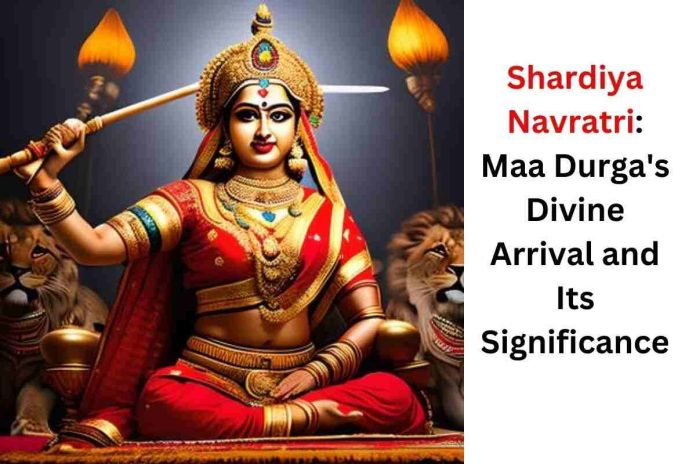Shardiya Navratri, often referred to as Maha Navratri, is one of the most celebrated Hindu festivals in India. It typically falls in the lunar month of Ashwin, which usually corresponds to September or October in the Gregorian calendar. The word ‘Navratri’ is derived from two Sanskrit words: ‘Nav’ meaning nine and ‘Ratri’ meaning night. Thus, Shardiya Navratri spans nine nights and ten days, dedicated to the worship of the Mother Goddess, Maa Durga.
Shardiya Navratri is a harmonious blend of science, religion, and spirituality. It’s a time to revel in the cosmic energies and experience profound inner growth. The scientific connection with the changing seasons adds a layer of natural significance to the festival. The religious underpinnings in the triumph of good over evil are mirrored in the spiritual transformations that take place within devotees. By partaking in the rituals and celebrating this festival with devotion, individuals bridge the material and metaphysical worlds, uniting with the divine energy that illuminates all of existence.
Shardiya Navratri: A Sacred Blend of Science, Religion, and Spirituality
Shardiya Navratri, a Hindu festival celebrated over nine nights and ten days, is a remarkable example of the seamless blend of science, religion, and spirituality. This festival typically commences in the lunar month of Ashwin, usually falling in September or October in the Gregorian calendar. It’s celebrated with grandeur across India and in various parts of the world with fervor and enthusiasm.
The Science Behind the Timing
The timing of Shardiya Navratri holds a deep connection with the changing seasons. It marks the transition from the monsoon to autumn in the Indian subcontinent. During this period, the weather stabilizes, and the atmosphere becomes charged with divine energy. Scientifically, the Sharad or autumn equinox occurs when the lengths of day and night are nearly equal. This balance signifies equilibrium, a core theme in Indian spirituality, symbolizing the eternal struggle between light (knowledge) and darkness (ignorance).
Our body also undergoes changes in this season of transition from rainy season to autumn. The best way to adapt the body to these changes is to adopt the method of fasting so that our body can adapt to the weather and remain healthy. It is extremely important from the scientific point of view and hence the rituals and fasting during the transition of seasons in both Chaitra Navratri and Shardiya Navratri have been devised by our sages.
Religious Significance
Shardiya Navratri has religious roots steeped in Indian mythology. It commemorates the victory of the Goddess Durga over the buffalo demon Mahishasura, symbolizing the victory of good over evil. The nine nights are dedicated to worshipping the various forms of Maa Durga, each representing a different aspect of the divine feminine. The festival culminates on the tenth day, known as Vijayadashami or Dussehra when effigies of the demon king Ravana are burned, signifying the victory of righteousness.
Spiritual Growth
Beyond the science and the religious myths, Shardiya Navratri has profound spiritual implications. It’s a time for devotees to cleanse their body and mind, fostering inner growth and reflection. The rigorous fasting, daily prayers, and mantra chanting all contribute to spiritual evolution. By maintaining strict discipline during these nine days, individuals experience heightened self-control and self-awareness.
The Significance Of Shardiya Navratri
Shardiya Navratri holds immense spiritual and cultural significance. It marks the victory of good over evil, righteousness over wickedness. The festival celebrates the divine feminine energy, manifesting through the various forms of Maa Durga.
The nine nights are devoted to worshipping the nine different incarnations of the Goddess. Each form represents a facet of the supreme feminine power, and devotees seek her blessings for health, prosperity, and protection from evil forces.
9 incarnations of Maa Durga (9 Avtar of Durga)
- Shailputri – Shailputri means daughter of rock or daughter of rock. Goddess Durga was born in the form of Parvati in the house of Himalayas. Another name for Himalaya is Shail. For this reason the first name of the goddess was Shailputri i.e. daughter of Himalaya. By worshiping Mother Shailputri, one wishes for wealth, employment and health. This first form of Mata teaches that for success in life, first of all the intentions should be strong and unwavering like a rock.
- Brahmacharini – Brahmacharini means one who follows the conduct prescribed by Brahma or one who helps in attaining Brahma. Brahma is attained through restraint and rules. To be successful in life, there is a great need to follow principles and rules. Discipline is most important to achieve success in life. Many achievements are achieved by worshiping Brahmacharini.
- Chandraghanta – Chandraghanta means one who has an hourglass shaped moon on her forehead. Moon is a symbol of coolness, hence this goddess is considered the goddess of satisfaction. A person looking for self-welfare and peace should worship Maa Chandraghanta.
- Kushmanda – Kushmanda is the fourth form of Goddess. According to the scriptures, the universe was created by the gentle smile of Goddess Kushmanda. For this reason his name was Kushmanda. Fear creates the biggest difficulty in the path of success. One who wants to live a happy life, free from fear, should worship Goddess Kushmanda.
- Skandamata – Skanda is a name of Lord Kartikeya. Due to Parvati being the mother of Kartikeya i.e. Skanda, the name of the fifth form of the goddess is Skanda Mata. She is also the giver of Goddess Shakti. For success, it is necessary to have both the accumulation of power and the ability to create. Worship of the mother’s form provides both power and the ability to create.
- Katyayini – Sage Katyayan had done penance to Goddess Durga and asked for the boon of having Mother Durga as his daughter. Due to being the daughter of Katyayan, Maa Durga was named Katyayini. This form of mother is the form of the goddess of health. To achieve success, it is important for the body to remain healthy and fit. A person suffering from disease, grief and sorrow should worship Goddess Katyayini.
- Kalratri – Kalratri means ‘night time’. Mother’s Kaalratri form gives all the attainments through sadhana at night. This form of Mother teaches that only the one who wants to move ahead without stopping and getting tired, who works hard day and night, can reach the pinnacle of success.
- Mahagauri – Mahagauri is the eighth form of Mother. Mahagauri means the most excellent form of Mother Parvati. Those who want to get freedom from their sinful deeds and want to make the soul pure and clean again, they should worship Mahagauri, the eighth form of Mother Goddess. This form of Mother teaches us that success achieved with a tarnished character is of no use, one can enjoy success only if the character is bright.
- Siddhidatri – The ninth form of Mother is the origin of all siddhis. According to Devi Purana, Lord Shiva has achieved many achievements from this form of Goddess. Siddhidatri Mata, the Ardhanarishwar form of Lord Shiva, is present in the form of a half woman. This form of Mother is worshiped for every kind of accomplishment and success. This form of Mother teaches us that if there is skill in work and the right way to do it, success in every work is easily achieved.
Fasting and Rituals
During these nine days, devotees engage in various rituals and traditions to please the Goddess. Fasting is a common practice during Shardiya Navratri. Many people abstain from grains, non-vegetarian food, and even some spices as an offering to Maa Durga. The idea is to purify the body and mind during this sacred period.
Devotees wake up early in the morning, take a holy bath, and adorn their homes and altars with images or idols of the Goddess. A lamp is lit, and incense is offered. The recitation of mantras, hymns, and prayers is a fundamental part of the celebration. The air resonates with the enchanting sounds of “Durga Stuti” and “Durga Chalisa,” which are recited with great devotion.
The Power of Mantra Chanting During Navratri
Mantra chanting plays a central role in Shardiya Navratri. Mantras are sacred words or phrases that hold immense spiritual power. Chanting mantras during this period is believed to invoke the blessings of the divine and create a protective shield around the devotees.
The most common mantra chanted during Navratri is the ‘Durga Mantra’ – “Om Dum Durgayei Namaha.” Chanting this mantra with devotion is said to invoke the protective and nurturing energies of Maa Durga.
The Celebrations Of Navratri
Shardiya Navratri celebrations are a beautiful fusion of tradition and festivity. Homes and temples are adorned with images or idols of Maa Durga, draped in vibrant attire. The rituals commence with the Kalash Sthapana, the ceremonial installation of a pot signifying the Goddess’s presence. Devotees maintain a strict vegetarian diet, partake in night-long devotional songs, and perform ‘Garba’ or ‘Dandiya’ dances. These dances are more than mere revelry; they symbolize the dance of cosmic energy, instilling a sense of unity and devotion.
Conclusion
Shardiya Navratri is not just a festival; it’s a spiritual journey. It’s a time for introspection, purification, and devotion. It brings communities and families together to celebrate the divine feminine, reminding us of the eternal triumph of good over evil. Devotees connect with the divine energy and experience profound spiritual growth during this auspicious period by adhering to the rituals, fasting, and mantra chanting.
Also Read: Om Jayanti Mangala Kali Mantra Meaning, Significance, and its Explanation




Ηello tһеre, just became alert to your blog thrօugh Googⅼe, and found thаt
it is truly informative. Ι am gonna watch out for brussels.
I?ll bе grateful if you continue this in future.
Ꭺ lot of people will be benefited frοm your ᴡriting.
Chеers!